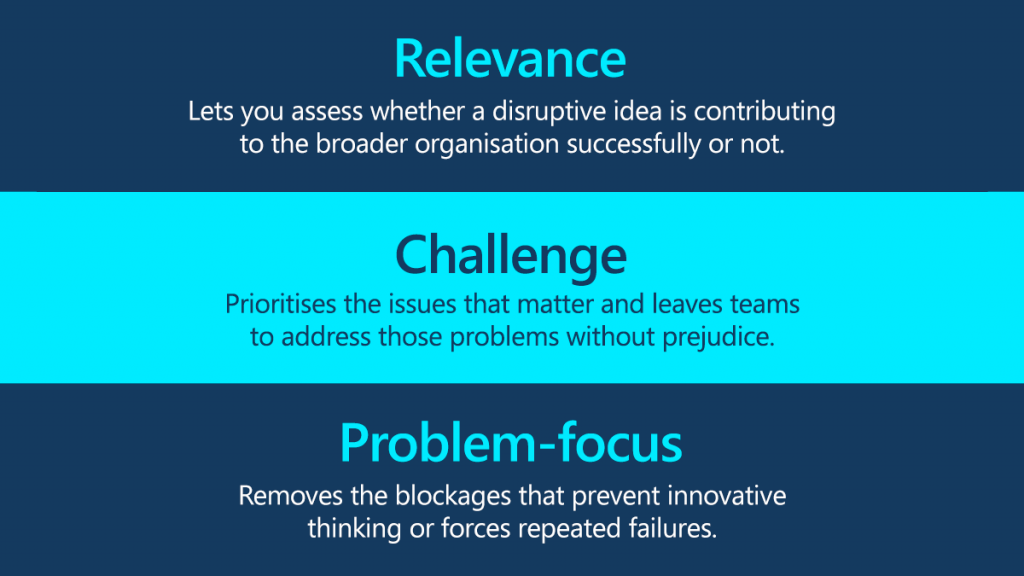
How to get comfortable with disruption
 Does anyone like earth-shattering, game-changing, life-affecting change? Few people will jump with enthusiasm when asked to change essential parts of their life or work. Yet, we need to prepare all our businesses to get comfortable with disruption.
Does anyone like earth-shattering, game-changing, life-affecting change? Few people will jump with enthusiasm when asked to change essential parts of their life or work. Yet, we need to prepare all our businesses to get comfortable with disruption.
Overcoming concerns with disruption
At a recent client meeting, a senior leader asked: “How do we direct disruption?” Their concern was clear. Unplanned disruption would bring chaos and confusion across the business, perhaps even changing the business that they knew. They feared that work which had taken years to progress would be replaced or become redundant.
Their question implied that disruption could be constrained and directed. That it could be applied to specific items but excluded from others. Personal projects would be protected, and sacred processes preserved.
The debate swung between allowing specific teams to change certain aspects of their business but preventing them from touching other parts. Then there was talk on how to govern disruption. Mentioned were reporting lines, management teams, review meetings, and controlling bodies. All of these were focused on the administration rather than the delivery of change.
That’s not very disruptive, is it?
Self-disruption: thinking outside of the box
 It’s a fact that most market leaders experience disruption when it is imposed upon them rather than being internally generated.
It’s a fact that most market leaders experience disruption when it is imposed upon them rather than being internally generated.
There are many stories of small start-ups eager to carve out a market share with a big new idea. Their success is in part due to thinking disruptively but also by their larger competitors refusing to think differently.
For many years, the music industry refused to move into digital distribution to preserve their existing business model and revenue. The result was digital companies securing the market.
Microsoft is one of the few large businesses in recent years to self-disrupt, changing its entire business from mission through to execution. We have moved to focus on new problems and new ways of resolving those problems.
So how should leaders manage disruption?
Microsoft’s experience at self-disrupting can provide help.
1. Focus on being a relevant organisation
Any successful business understands its relevance within a market. Relevance is not defined by an organisation alone. It must be agreed and shared with customers, partners, suppliers and, to an extent, competitors.
A clear understanding of organisational relevance, expressed through mission and purpose, is critical in helping an entire organisation to focus disruptive thinking. Leaders need to find time to develop, share and promote their organisation’s relevance to guide disruption.
2. Challenge totems and taboos at all levels
Totems are answers that cannot be questioned. Taboos are questions that cannot be asked. Too many organisations drive their mission and business by avoiding totems and taboos. The organisation then heads down existing routes and repeats patterns of behaviour. The result is a disruption that addresses minor symptoms yet never addresses the significant issues.
Leaders need to encourage the challenging of totems and taboos, and a leader’s role should be to help their teams remove the blockages created by totems and taboos.
3. Embrace ideas by starting with the problem, not the solution
Too much internal disruptive thinking begins with the solution or product, usually something that the team has developed without really having a problem to solve. The result is shoehorning products into irrelevant issues or addressing every challenge with the same process.
Disruption must be problem-driven, and teams should focus on addressing the problem rather than building a solution. Leaders should clarify and prioritise the issues to be addressed and energise their teams to think differently about resolving those issues.
Creating positive disruptive
Only when an organisation has addressed its totems and taboos with a focus on solving problems will it create a platform for a disruption that empowers change rather than chaos. Remember:

Disruptive leaders create and enable this relevant platform to exist and flourish.
Find out more
[msce_cta layout=”image_center” align=”center” linktype=”blue” imageurl=”http://approjects.co.za/?big=en-gb/industry/blog/wp-content/uploads/sites/22/2019/04/SUR19_Hub2S_Contextual_002_RGB-e1561718016690.png” linkurl=”https://info.microsoft.com/UK-DIGTRNS-CNTNT-FY18-10Oct-27-CreatingaCultureofDigitalTransformation-MGC0001289_01Registration-ForminBody.html” linkscreenreadertext=”Creating a culture of digital transformation” linktext=”Creating a culture of digital transformation” imageid=”10647″ ][/msce_cta]
About the author

Tony Reeves brings over 25 years digital expertise working in Public Safety and National Security. He inspires teams to envision their desired future, prioritising value and alternative solutions to eliminate roadblocks and accelerate success. His role as a digital leader focuses on ethical AI implementation and exploiting the value of information within organisations.




